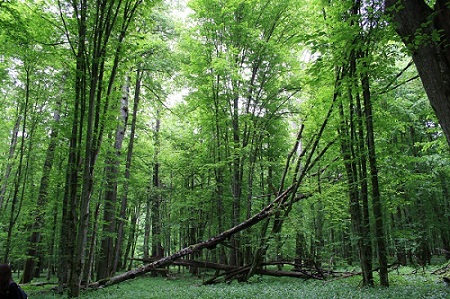How can history benefit the understanding of threatened species?

Temperate broadleaved forest in Bialowieza national park , eastern Poland. Photo: Tove Hultberg
by Tove Hultberg . Tove received her PhD in February 2015, at the Southern Swedish Forest Research Centre at SLU Alnarp. The blog is based on her PhD thesis "The long-term history of temperate broadleaves in southern Sweden".
Temperate broadleaves, such as oak Quercus, lime tree Tilia, maple Acer and hazel Corylus cover only a few percent of the forest land in Sweden today, yet hosts more than half of the threatened forest species in the country. This mismatch between habitat and associated species has been suggested to be due to a former larger abundance of the forest type – but how would you reasonably know what the landscape looked like a thousand years ago?
A very beneficial method for past vegetation reconstructions is pollen analysis, making use of the fact that pollen, which is released in huge amounts from most flowering plants, can be preserved for thousands of years in the anoxic environments of lakes and wetlands. Pollen analysis was introduced already in the late 19th century, but has an inherent problem – all plant taxa don’t produce the same amount of pollen, and pollen samples hence don´t equal the vegetation producing it. These differences can however now be overcome by applying a recently developed framework of models, the Landscape Reconstruction Algorithm (LRA), which can evaluate the past vegetation cover of different species using pollen data with considerably better precision than ever before.
Old data reveals a brand new landscape
Using the LRA and pollen data from multiple sites in southern Sweden, it was possible to show that temperate broadleaved forest covered more than half of the land area in southern Sweden 5000 years before present, and forest covered between 85 and 95% of the land in large parts of the region. Both forest cover and the cover of temperate broadleaves started to decline shortly after this point in time, probably largely as a result of the development of a cultural landscape in the region, with increasing proportions of cultivated fields, meadows and grasslands. However locally, in presently biodiversity hotspot areas, the temperate broadleaved forest type as well as the forest cover prevailed up to rather recently. These areas showed no signs of temperate broadleaved decline until during the most recent 500 years, during which the tree cover declined and open land taxa increased. However, direct indications of human impact, such as cultivation of cereals was rare, indicating that these presently protected areas were most likely less intensively used for cultivation than other areas in the surrounding. Perhaps they were considered less fertile and/or less accessible, and hence remained forested to a higher extent? Whatever the reason, this later exploitation is likely to be a direct reason for the high biodiversity and hence the protection today, but also for the survival of many threatened species associated with temperate broadleaves until today, although in small and vulnerable populations.
Continuity is crucial
The continuity of species composition, as well as of forest cover, seems to be highly important aspects of which areas are presently biodiversity hotspots, and which are not. Also in areas less rich in temperate broadleaves, both at present and in the past, the past continuity of forest cover as well as species composition and disturbance regimes are important for biodiversity. Examples of this can be seen in southeastern Sweden, where drought and recurring fires provided less beneficial conditions for temperate broadleaves than in many other parts of southern Sweden, but where the present biodiversity is notable. This is most likely connected to the very long forest continuity in parts of southeastern Sweden, as well as the continuous dominance of light-dependent tree species such as pine Pinus and birch Betula, which in combination with recurring fires provided open forest up to very recently.
However, also areas which have indeed been used for different agricultural practices are sometimes present biodiversity hotspots. In parts of southernmost Sweden, temperate broadleaves have been cleared to provide room for a cultural landscape, which in turn was replaced by invading beech forest. Beech Fagus sylvatica is the most recent temperate broadleaved tree species to colonize Sweden, and the high biodiversity found also in these secondary forests compared to their surroundings indicate that the continuity of temperate broadleaved forest ecosystem might be more important than continuity of individual temperate broadleaved species, probably due to the ability of many associated species to utilize more than one temperate broadleaved tree species.
Will today’s biodiversity prevail?
The great importance of continuity for present forest biodiversity is probably connected to both the limited dispersal of many presently threatened species, and to the fact the most other habitats than coniferous production forest are small and fractioned in today’s landscape. Today more than 60% of the land in southern Sweden is covered by forest - slightly more than half of which consists of spruce Picea, and another 30% by pine Pinus, and natural disturbances such as fire is highly eliminated. This borealization – or perhaps rather “sprucification” of the landscape has also affected the presently protected areas. Today Picea constitute ≥ 25% of the forest cover also in the studied protected areas. Hence, not even presently protected areas can be considered neither to be reflections of “natural” forest in southern Sweden, nor to have unbroken continuity back to ancient forests. The vegetation shift however did occur much more recently, and the proportions of “natural” vegetation, as well as the insect, lichen, and plant species associated with it is usually larger than in the region in general. If the (still ongoing) change towards more spruce and less temperate broadleaves is allowed to go on, the biodiversity values of these areas will be at risk. The present broadleaved vegetation and associated biodiversity could on the other hand rather be used as a resource, or refugia, from which both temperate broadleaves and associated species could be allowed to disperse and proliferate.
Lime tree as a case study
One of the temperate broadleaves which have confounded researchers since the introduction of pollen analysis is Tilia, lime tree, as it has been suggested to have been very abundant in northern Europe, yet produces very small amounts of pollen. The genus is presently represented by two species; Tilia cordata (small-leaved lime) and the presently extremely uncommon Tilia platyphyllos (large-leaved lime), but also the hybrid Tilia x europaea (common lime).
The genus Tilia is very rare in natural habitats in Sweden today. Using pollen data from more than 40 sites in southern Sweden and the recently developed LRA, it was however possible to demonstrate that Tilia had indeed been common in large parts of the area in the past. In general it was most abundant during the warm period known as the Holocene Thermal Maximum, which ended approximately 4800 years before present. After that, the lime tree population declined in the somewhat more northern and somewhat colder hemi-boreal zone, whereas the climate deterioration did not have any apparent effect on the lime tree population of the more southern, temperate, zone. In the temperate zone, lime tree did not decline until thousands of years later, in close temporal connection to increasing proportions of cereal pollen around 1300 years before present.
Human impact can destroy – or support
The decline both concerning lime tree in southernmost Sweden and temperate broadleaves in general seem to be closely connected to land use changes, such as forest clearance for agricultural purposes (establishment of arable land, meadows and grazed lands), but also forest grazing and browsing by domestic animals in existing forests. This is important in order to understand the cause of the present threat towards species associated with temperate broadleaves, but also to understand how to maintain and benefit these species in the future. Furthermore, the notion than human impact was crucial for the decline in temperate broadleaves also indicates that it is within our power to get them back.






Comments
Post new comment